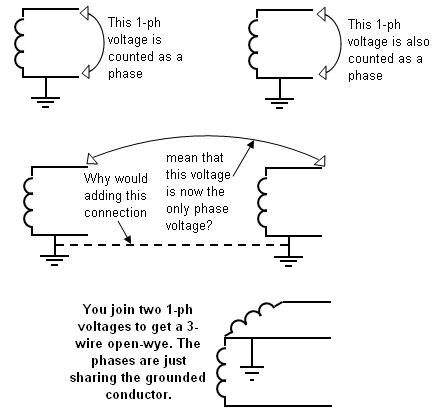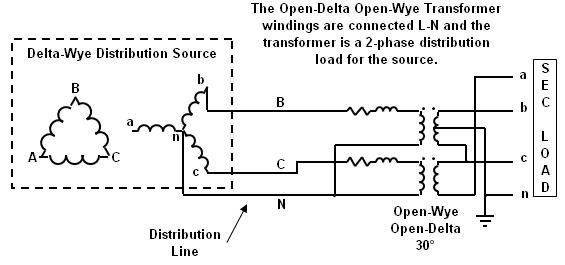L-N voltages only exist in systems that have neutrals, so this is cannot be a universal method of counting phases.
Neither are the voltages universal. We can get both L-L and L-N from some sources. Considering that I am following the general rule of polyphase systems, the L-N & L-L voltages are phases in two different systems.
Consider for a moment the windings as a source phase, when you connect them in a wye configuration, it should be obvious that the phases are line-common.
You seem to want to ignore the common conductor's role as a conductor; I don't. After all, the polyphase systems are merely combinations of individual 2-wire phases. The common conductor just reduces the amount of wire we have to use for the combined system because the individual phases are sharing one of their conductors with the group.
Wait a minute if a 'phase is a voltage' to a common reference point, what difference should it's magnitude make. This logic would say that an unbalanced wye system is no longer 3-phase
If you will note in my previous posts that the precise term was "substantially equal in magnitude". That gets to be a mouthful to say every time. Besides, I think you know what I meant. We are all familiar with nominal ratings and such.
What you did not seem to catch was that I said a system of voltages will be grouped by magnitude. Three-phase 120v, three-phase 208v, etc. Inside each magnitude group will be sub-groups gathered by phase angle. The number of internal sub-groups determines the phase order of each magnitude group.
For help in the use of commas, I like the book "Eats Shoots & Leaves" by Lynne Truss.
I'll check it out, but that has nothing to do with how other people use commas. Maybe they did not read that book and we can't just project a specific comma use onto someone else's literature.
I do see different perspectives. I just don't agree with them
Fair enough
I never said the author was an anomaly, only that the language usage was not common.
Guess it depends on where you travel. It was pretty common for the author, and in addition to authoring many publications dealing with industrial and utility system analysis, he develops industry-leading distribution analysis software used by many utilities, schools, and engineers in the US and around the world.
I did not quote standards as being definitive. At what point did I disagree with "standards". I spoke definitively about common usage by electrical equipment manufacturers.
One of the IEEE standards says that the 4-wire and 5-wire 2-phase system would be more properly called a 4-phase system, which you disagree with. There are other industry-standard reference texts which say the same thing. Nothing wrong with disagreeing with them as long as you have a valid reason. Even your methodology has issues because there are four line-line voltages.
I cited two large utilities that do not commonly use the term "2-phase" in the publications they provide to their customers.
I would venture to say almost all of the utilities don't. There is no reason to change the conventional names.
As for the "open-wye", I would say there might be a good mixture of some who call it a "single-phase service" and some who call it a "network service", even though "network service" has probably been around longer.
I understand what you are trying to say. I don't agree with it.
Sometimes the things you paraphrase make me wonder because they are not what I have said. I'll take it on faith that you are at least making an effort.
I have a methodology that works every time when counting the number of phases in a system and matches the terminology that is most prevalent in our industry. I count only the voltages between 'line/hot/phase' conductors (i.e. the same conductors that we say carry 'phase currents' and are historically, although slightly unfortunately , labeled as "Phase A, Phase B, and Phase C").
I would (and have) question(ed) that it works every time. It certainly needs some exceptions added to what you just said. For one, there is no line-line voltage on a 2-wire grounded+ungrounded configuration and I know you don't call it zero-phase. How is it that you consider the individual phase's 2-wire voltage but want to ignore it when it becomes part of a larger group?
Your method of saying 3-wire (2 lines and a common) systems are '2-phase' is absolutely not useful in describing the physical systems unless you also include the angle between the voltages.
I have been saying all along that you use the angles along with the magnitudes.
While I see that our present naming conventions have some problems, especially for the casual user (one not trained in power systems), I do not see any improvement by simply dding the term "2-phase" simply in an effort to describe how loads are connected to supplies.
I agree that that terminology is definitely lacking
This is why I have regularly tried to describe my systems like: 120/240 1PH 3W, 240/120 3PH 4W, 120/208 1PH 3W, and 208Y/120 3PH 4W.
That is certainly a better way to go.


